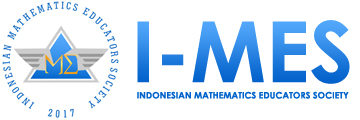ANALISIS BUKU PENILAIAN (BUPENA) MATEMATIKA WAJIB BERDASARKAN STANDARDS FOR MATHEMATICAL PRACTICE (SMP)
Abstract
Keywords
Full Text:
PDFReferences
Abdullah, A. H., Ibrahim, N. H., Surif, J., Ali, M., & Hamzah, M. H. (2014). Non-routine Mathematical Problems among In-Service and Pre-Service Mathematics Teachers. International Conference of Teaching, Assessment and Learning (TALE), 18-24.
Abdullah, A. H., Rahman, S. N., & hamzah, M. H. (2017). Metacognitive Skills of Malaysian Students in Non-Routine Mathematical Problem Solving. Bolema, Rio Claro (SP), 31(57), 310-322.
Andriana, Y. P. (2014, Februari 27). eprints Universitas Muhammadiyah Surakarta . Retrieved from http://eprints.ums.ac.id/: http://eprints.ums.ac.id/28683/13/NASKAH_PUBLIKASI.pdf
Apino, E., & Retnawati, H. (2016). Developing Mathematical Higher Order Thinking Skills of Senior High School Students. MSCEIS (pp. 1-8). Bandung: Universitas Pendidikan Indonesia.
Araiku, J., Parta, I. N., & Rahardjo, S. (2019). Analysis of students’ mathematical problem solving ability as the effect of constant ill-structured problem’s employment. Journal of Physics: Conference Series, 1166(1), 12-20. doi:10.1088/1742-6596/1166/1/012020
Araiku, J., Sidabutar, R., & Mairing, J. P. (2019). Gender Differences in Mathematics Ability of Junior High School Students based on Bloom's Taxonomy. Jurnal Gantang, 4(1), 15-25. doi:10.31629/jg.v4i1.969
Arroida, A. K., & Retnawati, E. (2018). Analisis Buku Teks Pelajaran Matematika Wajib Kelas X SMA. Jurnal Pendidikan Matematika, 7(3), 1-13.
Barabash, M., & Guberman, R. (2013). Developing Young Students’ Geometric Insight. Based On Multiple Informal Classifications as a Central Principle in the Task Design. Proceedings of ICMI Study 22, 1, 295-303.
Berland, L. K., & Forte, A. (2010). When students speak, who listens? Constructing arguments in classroom argumentation. 9th International Conference of the Learning Sciences (pp. 428-435). Chicago: Association for Computing Machinery.
Brookhart, S. M. (2010). How to assess higher-order thinking skills in your classroom. Alexandria: ASCD.
CCSSI. (2020, April 2). Standards for Mathematical Practice. Retrieved from Common Core State Standards Initiative: http://www.corestandards.org/Math/Practice/
CCSSO. (2010). Common core state standards for mathematics. Washington, DC: CCSSO.
Conklin, W. (2012). Higher-order thinking skills to develop 21st century learners. Huntington Beach: Shell Educational Publishing, Inc.
Courtney, S. A. (2014). Moving the Standards for Mathematical Practice Beyond Bullet Points. Comprehensive Journal of Educational Research, 2(5), 70-87.
Eyyam, R., & Yaratan, H. S. (2014). Impact of Use of Technology in Mathematics Lessons on Student Achievement and Attitudes. Journal of social behavior and personality, 42, 31-42. doi:10.2224/sbp.2014.42.0.S31
Fernandez-Leon, A., Izquierdo, J. M., & Toscano, R. (2017). How mathematicians conjecture and prove: An approach from mathematics education. Proceeding of CERME10, 2041-2048.
Foster, C. (2017). Developing mathematical fluency: comparing exercises and rich tasks. Educ Stud Math, 97(1), 121-141.
Hobden, P. (1998). The Role of Routine Problem Tasks in Science Teaching. In K. Tobin, & B. Fraser, International Handbook on Science Education (pp. 219-231). Dordrecht: Kluwer.
?mamo?lu, Y., & To?rol, A. Y. (2015). Proof construction and evaluation practices of prospective mathematics educators. European Journal of Science and Mathematics Education, 3(2), 130-144.
Magfirah, Maidiyah, E., & Suryawati. (2019). Analisis kesalahan siswa dalam menyelesaikan soal cerita matematika berdasarkan prosedur newman. Lentera Sriwijaya: Jurnal Ilmiah Pendidikan Matematika, 1(2), 1-12. doi:10.36706/jls.v1i2.9707
Margolinas, C. (2013). Task Design in Mathematics Education. Proceedings of ICMI Study 22, 1, 9-15.
Mateas, V. (2016). Debunking Myths about the Standards for Mathematical Practice. Mathematics Teaching In The Middle School, 22(2), 92-99.
Milinkovi?, J., Djoki?, O., & Deji?, M. i. (2008). Model udžbenika kao osnove aktivnog u?enja u nastavi matematike. Inovacije u nastavi, 21(1), 70-79.
Murray, E. H. (2011). Implementing Higher Order Thinking in Middle School Mathematics Classrooms (Doctoral dissertation). Athens: University of Georgia.
NCTM. (2000). Principles and standards for school mathematics. Reston, Virginia: NCTM.
O'Connell, S., & SanGiovanni, J. (2013). Putting the Practices Into Action: Implementing the Common Core Standards for Mathematical Practice. Canada: Pearson Canada Inc.
Pepin, B. (2008, November 11). Mathematical tasks in textbooks: Developing an analytical tool based on connectivity. Retrieved from ICME 11: http://dg.icme11.org/tsg/show/18
Polya, G. (1973). How to Solve It. Princeton: Princeton University Press.
Robitaille, D. F., & Travers, K. J. (1992). International studies of achievement in mathematics. In D. A. Grouws, Handbook of Research on Mathematics Teaching and Learning (pp. 687-709). New York: Macmillan Publishing Company.
Susac, A., Bubic, A., Vrbanc, A., & Planinic, M. (2014). Development of abstract mathematical reasoning: the case of algebra. Frontiers in Human Neuroscience, 8(679), 1-10.
Tajudin, N. M. (2017). Role of higher order thinking skills in enhancing mathematical problem solving. Man in India, 97(17), 209-214.
Taqiyuddin, M. (2019, November 11). https://www.researchgate.net/. Retrieved from researchgate: https://www.researchgate.net/publication/333015100_ANALISIS_BUKU_MATEMATIKA_SEKOLAH_MENENGAH_ATAS_PADA_TOPIK_TURUNAN/link/5cd662ce299bf14d9589c384/download
Thompson, P. W. (2011). Quantitative Reasoning And Mathematical Modeling. WISDOMe, 1, 33-57.
TIMSS. (1999, September 1). International Mathematics Report Findings from IEA’s Repeat of the Third International Mathematics and Science Study at the Eighth Grade. Retrieved from TIMSS 1999 Publication: http://timss.bc.edu/timss1999i/math_achievement_report.html.
Umulis, D. M., & Othmer, H. G. (2015). The Role of Mathematical Models in Understanding Pattern Formation in Developmental Biology. Bull Math Biol, 77(5), 817-845.
Valvarde, G. A., Bianchi, L. J., Wolfe, R. G., Scmidt, W. H., & Houng, R. T. (2002). According to the Book Using TIMSS to investigate the translation of policy into practice through the world of textbooks. Dordrecht: Kluwer Academic Publishers.
Warwick, J. (2007). Some Reflections on the Teaching of Mathematical Modeling. The Mathematics Educator, 17(1), 32-41.
Widjaja, W. (2013). The Use Of Contextual Problems To Support Mathematical Learning. IndoMS-JME, 4(2), 151-159.
DOI: https://doi.org/10.36706/jls.v2i1.11540
Refbacks
- There are currently no refbacks.
Copyright (c) 2020 Lentera Sriwijaya : Jurnal Ilmiah Pendidikan Matematika
Jl. Srijaya Negara, Bukit Besar
Palembang - 30139 Indonesia
Indexed in:
Lentera Sriwijaya: Jurnal Ilmiah Pendidikan Matematika is licensed under a Creative Commons Attribution-NonCommercial 4.0 International License.
View My Stats



